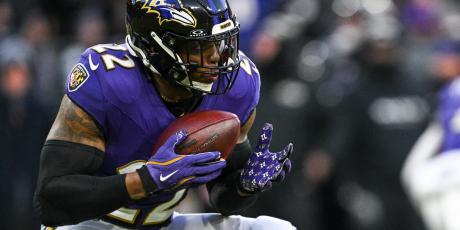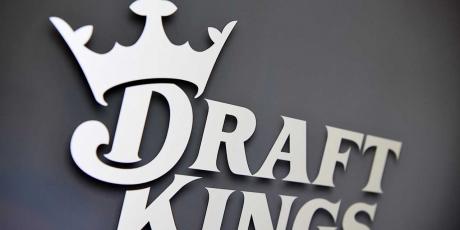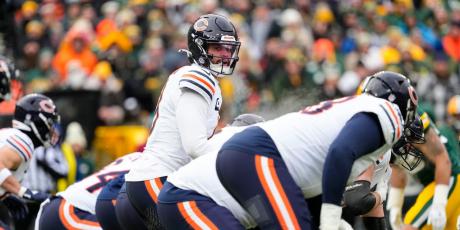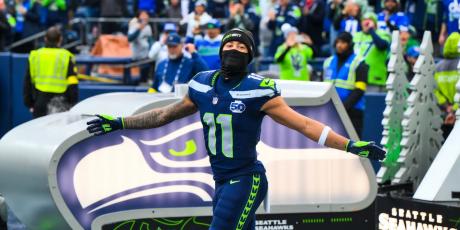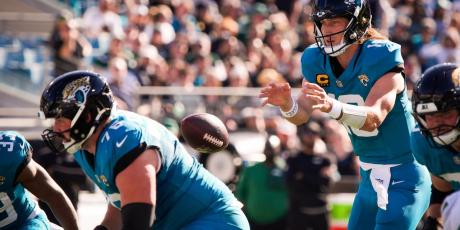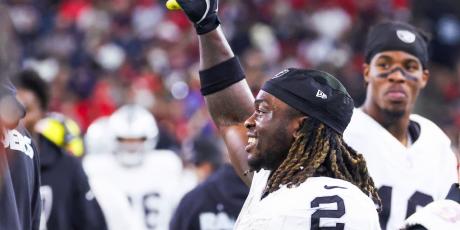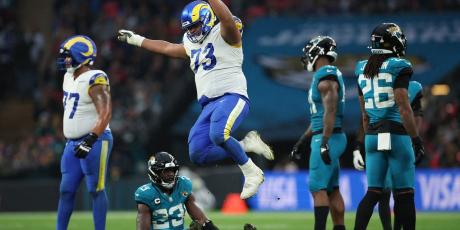How Reliable are Rookies in Fantasy Football?

Every year, the NFL becomes more and more popular with fans, and that’s not only true from the months of September through January. Annual off-season events such as the Rookie Combine and the NFL Draft are heavily covered by the media and draw the attention of a large percentage of football fans each spring.
This increased attention has led to a higher awareness of NFL players in general, but especially of the incoming rookie class, as they are the ones heavily involved in many offseason events. In turn, the knowledge of the typical fan and average fantasy player has heavily increased the number of rookies being drafted in fantasy football leagues.
Using MyFantasyLeague.com average draft position (ADP) data in redraft leagues, let’s take a look at the number of rookies drafted dating back to 2010:
| Year | QB | RB | WR | TE | Total |
|---|---|---|---|---|---|
| 2010 | 4 | 4 | 8 | 5 | 21 |
| 2011 | 4 | 9 | 9 | 3 | 25 |
| 2012 | 5 | 10 | 13 | 2 | 30 |
| 2013 | 2 | 10 | 14 | 3 | 29 |
| 2014 | 3 | 12 | 16 | 5 | 36 |
| 2015 | 2 | 16 | 20 | 4 | 42 |
| 2016 | 9 | 21 | 29 | 7 | 66 |
With the huge increase of rookies being drafted in fantasy in 2016, it is imperative that we as drafters develop a sharp approach towards these new players. Recent data can give us all we need to know about what to do with these players in our upcoming drafts.
What exactly should we expect when adding these inexperienced players to our teams?
Do these players regularly outperform their ADP?
Are they truly worthy of a roster spot in the fantasy football typical league?
Is it fair to rely on rookies as fantasy starters?
The numbers provide a grim outlook. Let’s examine each of these questions based on the previously mentioned ADP and seasonal scoring data.
Do Rookies Regularly Outperform Their ADP?
When you draft a player in fantasy, it's with the hope and expectation that he can give you a high return on investment. For example, if you draft the tenth quarterback off the board, you’re hoping for a finish even higher than tenth. Considering rookies are not typically drafted highly in redraft leagues, I expected the percentage of players out-producing their ADP to be relatively high.
| Position | Number of Rookies Drafted (2010-2015) | Number of Rookies Outperforming ADP | Percentage of Rookies Outperforming ADP |
|---|---|---|---|
| QB | 20 | 16 | 80% |
| RB | 61 | 35 | 57% |
| WR | 80 | 30 | 38% |
| TE | 22 | 8 | 36% |
Looking at these numbers, we see a stark difference between the four positions. While the rookie quarterbacks look like a strong bet to outperform their ADP, the pass catchers are far from safe. Under 40% of rookie wide receivers and tight ends provided a solid return on their ADP.
These numbers are a bit skewed though. After all, fantasy owners are rarely drafting rookie quarterbacks early in their drafts, so taking a late flier on a rookie quarterback could easily pay off. Of the 20 signal callers drafted in redraft leagues from 2010-2015, 16 of them outperformed their ADP, but the average ADP of the group was just 175.3, which is the fifteenth round of a typical 12-team league. It doesn't take much to return value on that type of late-round investment. Robert Griffin back in 2012 was the only rookie to be drafted among the top 12 quarterbacks, and he was able to pay off that value, finishing as the QB5 that season.
While not nearly matching the 80% clip of rookie quarterbacks, rookie running backs offer a solid return on investment as well, with 57% of rookie backs finishing higher than their preseason ADP. Rookie runners do carry higher expectations, as one or two backs are typically drafted in the top 24 with a starting role in mind. Often though, the runners carrying those lofty expectations are the ones who disappoint, while little-knock rookie backs surprise the fantasy football community (more on that later).
Both the wide receiver and tight end positions look like huge disappointments with 38% and 36%, respectively, of rookies outperforming their redraft ADP. The reasons for this subpar performance vary.
In the case of wide receivers, there are simply so many of them being drafted (80 over the six-year span) that the percentage of those who hit is bound to be low. With more and more fantasy owners adopting a Zero RB strategy and loading up on wideouts, this is bound to continue.
For rookie tight ends, there is a clearer explanation. We can’t count on rookies at this position, plain and simple. Only eight of the 22 tight ends drafted exceeded their ADP, and only three have done so in the past five years. It is often said that tight ends take three years to develop, something we used to hear about wide receivers before the expectations placed on them became astronomical. You’ll see more on this later, but there is really no reason to draft or roster a rookie tight end in redraft leagues.
Are Rookies Worthy of a Roster Spot in Redraft Leagues?
Answering this type of question can be a challenge. After all, there are many pieces of information that are needed to truly provide the best answer. When looking back at data, it is fair to assume that any player worthy of a roster spot is performing at a starting or primary fantasy backup level. Let’s assume a lineup consisting of a quarterback, two running backs, three wide receivers and a tight end. That sets the bar at a top-24 scorer for both quarterback and tight end, top-48 for running backs and top-60 for receivers.
| Position | Number of Rookies Drafted (2010-2015) | Number of Rookies Performing at Roster Level | Percentage of Rookies Performing at Roster Level |
|---|---|---|---|
| QB | 20 | 13 | 65% |
| RB | 61 | 37 | 61% |
| WR | 80 | 31 | 39% |
| TE | 22 | 6 | 27% |
Again, the data suggests rookie quarterbacks may not be such a poor investment, with 13 of the 20 drafted ending their rookie campaign in the top 24 fantasy scorers. Quarterback scoring over a full season often comes down to opportunity. It sounds simple, but when drafting a backup quarterback, I want to ensure I am actually acquiring a Week 1 starter. This can eliminate many rookies each year.
Running backs perform better in this category than they do in outperforming their own ADP, which is somewhat amazing. The running back position accounted for the majority of roster-worthy rookies: 37 over the past six seasons. It takes both wide receivers and tight ends combined to even match that number. Given the landscape change across the NFL with more and more teams using multiple runners, rookie backs can be a wise and cheap investment in the latter portions of a fantasy draft.
Similar to the previous set of data, the pass catchers did not show well when looking at how many are even worthy of a roster spot. Again, this has something to do with the large number of receivers being drafted each year, but there’s more to it than that. Rookie receivers deal with many adjustments and rarely enter the league as starters, let alone top targets in their respective offenses. This lack of involvement can obviously make it difficult to put up fantasy points.
Before we move on to our final question, let’s quickly break down the above data one more time. After all, when considering if these players outperform their ADP or prove their roster spot worth, we’ve been looking at all rookies drafted in seasonal leagues, all the way down to players like Mardy Gilyard and Ryan Broyles.
Instead of digging so deep into ADP, let’s narrow the rookie pool to those fantasy owners are truly relying on for high-level production. When looking only at the players chosen in the top 100 of drafts, the data changes:
| Position | Number of Rookies Drafted in Top 100 | Number of Top 100 Rookies Outperforming ADP |
|---|---|---|
| QB | 1 | 1 |
| RB | 17 | 7 |
| WR | 8 | 4 |
| TE | 0 | 0 |
At both the quarterback and tight end position, our sample size is very small, or even non-existent. Only one quarterback in the past six seasons (RG3) has been selected in the top-100 of redraft picks. No rookie tight ends over that time span have been top-100 selections, which is just as it should be.
This is one area in which the rookie backs have been disappointing. Of the 17 runners drafted as top-100 picks, just seven have offered a solid return on investment. Three of those came in 2012, as Doug Martin, Trent Richardson, and Alfred Morris all finished among the top-eight running back scorers.
Four of the eight receivers drafted in the top-100 returned value, with three of those who failed to do so occurring last season. Kevin White never got the chance to live up to his draft value, while Nelson Agholor was a huge disappointment. The third was Amari Cooper, who -- despite finishing as WR21 -- couldn’t quite match his lofty WR17 ADP. There’s no shame in a WR21 finish for a rookie, but that goes to show there were likely many better options at that draft range.
Should You Rely on Rookies as Fantasy Starters?
Exactly how many rookies perform at a starting fantasy level during their first season?
For the purpose of this study, I’ve defined fantasy starters as one quarterback, two running backs, three wide receivers, one tight end.
| Position | Total # Drafted | # of Starting Level Seasons | Percentage of Rookies Performing as Starters |
|---|---|---|---|
| QB | 20 | 4 | 5% |
| RB | 61 | 13 | 9% |
| WR | 80 | 12 | 5% |
| TE | 22 | 1 | 1% |
Strictly looking at these numbers, it doesn’t look like a wise choice to draft any rookies. With single-digit percentage odds of landing a starting level rookie in fantasy, are they even worth the risk?
Let’s begin by looking at the quarterback position. The general perception of rookie quarterbacks has changed over the past few years. It wasn’t long ago that young quarterbacks were expected to sit and learn for their inaugural season. Recently, however, that trend has turned. Now, rookie quarterbacks -- even those drafted in later rounds -- are seeing early playing time as teams look under every rock for their next franchise quarterback.
Over the past six seasons, there have been 29 rookie signal callers drafted in redraft leagues. Of those 29, just four have produced a top-12 season. Interestingly, three of those four came in 2012, as Robert Griffin, Andrew Luck and Russell Wilson shook up the league.
As I previously mentioned, running backs are used early and often. In today’s NFL, every team uses at least two. While the percentage of success is still low, the data shows that of all positions, it is easiest to find a fantasy starter amongst the rookie running back pool.
On average, only two rookie receivers per year find their way into the top-36. Considering the number of receivers being drafted has increased every year and is now up to 29, the odds don’t look good.
Finally, and as I’ve already mentioned, there is no reason at all to roster rookie tight ends. Just one rookie in the past six years has cracked the top 12 (Rob Gronkowski in 2010). If that isn’t bad enough, only five other rookies have even finished among the top-24.
The Rookie Class of 2016
I’ve answered some questions involving players from past years, but the real question that is pressing now involves the current crop of rookies. Which rookies are worth roster spots? Which rookies could become fantasy starters? Let’s check out the current ADP data for each position.
Quarterback
| Name | Overall ADP | QB Rank (based on ADP) |
|---|---|---|
| Jared Goff | 139.36 | QB25 |
| Carson Wentz | 156.6 | QB29 |
| Paxton Lynch | 157.53 | QB30 |
| Christian Hackenberg | 230.51 | QB38 |
| Dak Prescott | 231.59 | QB39 |
| Cardale Jones | 243.97 | QB40 |
| Cody Kessler | 275.92 | QB43 |
| Connor Cook | 293.43 | QB45 |
| Jeff Driskel | 303.29 | QB47 |
While many rookie quarterbacks can outperform their late ADP if they luck into a starting job due to injury, I only see one player I’m willing to roster in redraft leagues and that is the top overall NFL Draft pick: Jared Goff. The former Cal quarterback is set to start for the Los Angeles Rams from day one (even though the Rams attempt to deny it) and it would be no surprise if the team struggles and is forced to throw early and often.
While there were a pair of other first round draft picks, Carson Wentz and Paxton Lynch, there are early reports that both could sit for much of their first season. As I mentioned earlier, when targeting a backup quarterback, I want to ensure that player will actually start. There is simply not enough upside with these players to spend a pick on them in all but the deepest redraft leagues.
Running Back
| Name | Overall ADP | RB Rank (based on ADP) |
|---|---|---|
| Ezekiel Elliott | 12.9 | RB3 |
| Derrick Henry | 98.32 | RB31 |
| C.J. Prosise | 117.49 | RB35 |
| Kenneth Dixon | 117.99 | RB36 |
| Devontae Booker | 135.96 | RB41 |
| Jordan Howard | 152.89 | RB47 |
| Paul Perkins | 156.38 | RB49 |
| DeAndre Washington | 164.08 | RB50 |
| Kenyan Drake | 173.96 | RB52 |
| Wendell Smallwood | 175.32 | RB53 |
| Keith Marshall | 184.96 | RB58 |
| Jonathan Williams | 192.8 | RB59 |
| Josh Ferguson | 198.47 | RB61 |
| Tyler Ervin | 210.04 | RB64 |
| Alex Collins | 212.32 | RB65 |
| Daniel Lasco | 238.47 | RB75 |
| Kelvin Taylor | 243.69 | RB77 |
| Dwayne Washington | 270.33 | RB85 |
| Peyton Barber | 290.4 | RB92 |
| Darius Jackson | 304.94 | RB93 |
| Marshaun Coprich | 325.15 | RB94 |
Yes, an incoming rookie is being drafted as the third overall running back, and it’s not a reach. Over the past two seasons, we’ve seen what that Dallas offense can produce when it comes to the running game. A record setting season from DeMarco Murray was one thing, but a 1,000 yard season from Darren McFadden is completely different.
Beyond the expected superstar season and career from Elliott, there are some other interesting players to consider in this rookie class. Several backs, including Derrick Henry, CJ Prosise, Jordan Howard and DeAndre Washington seemingly already have roles with their teams, lending them solid value before they even take an NFL snap. Given their late-round ADPs, many of these rookies seems like safe bets to provide value to their fantasy owners, but I wouldn’t bother taking any of the backs beyond the RB60 range.
Wide Receiver
| Name | Overall ADP | WR Rank (based on ADP) |
|---|---|---|
| Corey Coleman | 63.47 | WR30 |
| Laquon Treadwell | 71.23 | WR35 |
| Sterling Shepard | 78.13 | WR38 |
| Josh Doctson | 92.8 | WR41 |
| Michael Thomas (NO) | 107.35 | WR45 |
| Will Fuller | 138.02 | WR54 |
| Tyler Boyd | 138.69 | WR55 |
| Leonte Carroo | 147.93 | WR59 |
| Malcolm Mitchell | 181.52 | WR68 |
| Tajae Sharpe | 189.06 | WR72 |
| Braxton Miller | 189.46 | WR73 |
| Pharoh Cooper | 193.76 | WR74 |
| Mike Thomas (LA) | 199.4 | WR78 |
| Rashard Higgins | 213.64 | WR83 |
| Demarcus Robinson | 240.89 | WR92 |
| Keyarris Garrett | 245.44 | WR95 |
| Chris Moore | 247.08 | WR96 |
| Jordan Payton | 248.87 | WR98 |
| Moritz Boehringer | 255.21 | WR101 |
| Ricardo Louis | 260.09 | WR104 |
| Charone Peake | 263.53 | WR105 |
| Daniel Braverman | 270.94 | WR110 |
| Marquez North | 297.45 | WR124 |
| Roger Lewis | 307.63 | WR127 |
| D.J. Foster | 308.92 | WR128 |
| Kenny Lawler | 330.56 | WR133 |
| Kolby Listenbee | 332.42 | WR134 |
| Devon Cajuste | 335.1 | WR135 |
| Aaron Burbridge | 337.77 | WR136 |
I noted earlier that on average, two rookie wide receivers tend to finish as fantasy starters. While there are many talented players in the '16 class, the two current favorites for those spots have to be Corey Coleman and Sterling Shepard. Coleman could and should be the top targeted receiver on the Browns team considering the lack of talent on their depth chart. Shepard is a different case; he’s no threat to the top receiver Odell Beckham, but he could provide OBJ with an excellent sidekick. With Rueben Randle gone and Victor Cruz seemingly always injured, Shepard is the strong favorite to be the WR2 in one of the league’s most pass-happy offenses.
Other rookies being drafted later are also in line for early playing time, and potentially even starting roles. These include Will Fuller in Houston, Tyler Boyd in Cincinnati, and Tajae Sharpe in Tennessee. While I like gambling on the majority of the rookies, I wouldn’t waste a spot on any outside of the top 100 wideouts.
Tight End
| Name | Overall ADP | QB Rank (based on ADP) |
|---|---|---|
| Hunter Henry | 167.43 | TE21 |
| Austin Hooper | 184.3 | TE23 |
| Tyler Higbee | 220.72 | TE30 |
| Jerell Adams | 253.28 | TE36 |
| Seth DeValve | 258.04 | TE37 |
| Nick Vannett | 285.65 | TE42 |
| Ben Braunecker | 360.5 | TE47 |
Again, don’t draft any rookie tight ends. Just don’t. Fortunately, none of them are being drafted very highly. While both Austin Hooper and Tyler Higbee could be in line to start right away for their respective teams, they would still be far down the pecking order when it comes to targets in the passing game.
Still not a subscriber? Sign up here!
Related Articles
- Which Fantasy Football Rookies WIll Make an Immediate Impact?
- What to Expect from the Rookie WR Class Over the Next 3 Seasons
- What to Expect from the Rookie RB Class Over the Next 3 Seasons
- How do Rookies Compare to Veterans with Similar ADPs?
- The Raiders Have One of the Most Valuable Backfield Situations in Fantasy

